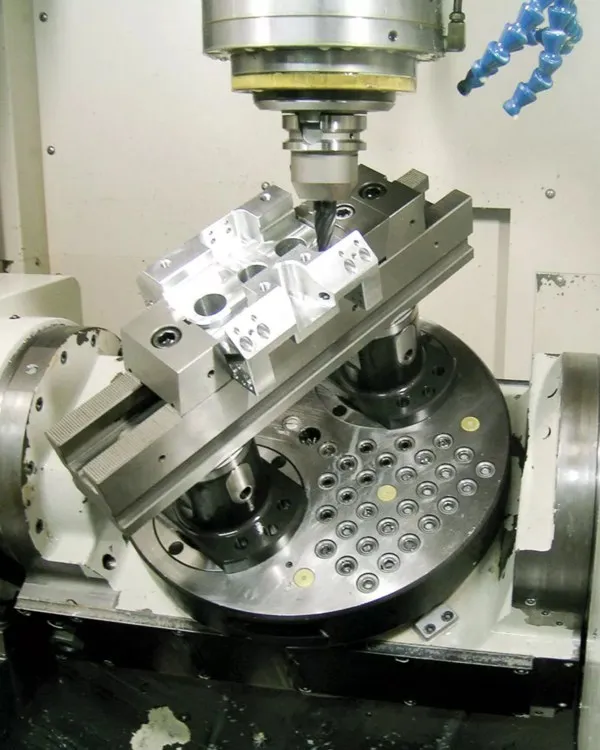Understanding 5-Axis Machine Structures
To fully grasp 5-axis machining, one must first understand the structure of 5-axis machines. A 5-axis machine comprises three linear axes (X, Y, Z) and two rotational axes (A, B, C). These rotational axes offer different types of motion to meet diverse technical requirements.
Machine designers are continuously developing new motion modes to address various needs. Although 5-axis machines come in various designs, they can generally be categorized into the following types:
Dual Rotary Head Type: Both rotational coordinates control the tool axis direction. Tilting Rotary Head Type: Rotational axes are at the tool tip, but are not perpendicular to the linear axes. Dual Rotary Table Type: Dual rotating coordinates control spatial rotation. Tilting Table Type: Rotational coordinates are on the worktable, but are not perpendicular to the linear axes. One Rotation, One Tilt Type: One rotational coordinate acts on the tool, and the other acts on the workpiece. Note: A rotational axis not perpendicular to a linear axis is referred to as a “tilting” axis.
Having explored these machine structures, we should understand the mechanical principles and movement mechanisms of 5-axis machines. But how do these diverse structures impact machining characteristics? And how do they compare to traditional 3-axis machines? Let’s delve into the standout features of 5-axis machines.
Advantages of 5-Axis Machining
When discussing the benefits of 5-axis machines, it's crucial to compare them with traditional 3-axis equipment. Common 3-axis machines include vertical, horizontal, and gantry types, utilizing methods such as end milling, side milling, and ball-end milling. However, these methods share a limitation: the tool axis direction remains fixed during machining, relying solely on the X, Y, and Z linear axes for movement. This limitation becomes apparent when machining complex products, revealing inefficiencies and quality issues.
Compared to 3-axis CNC machines, 5-axis machines offer several advantages:
Optimized Cutting Conditions: 5-axis machines maintain the tool’s optimal cutting state, improving cutting conditions. Unlike 3-axis machines, which often require multiple rotations of the worktable to maintain optimal cutting conditions, 5-axis machines avoid issues like zero line speed with ball-end mills, resulting in superior surface quality.
Reduced Tool Interference: 5-axis machines can handle complex parts such as aerospace engine blades and impellers, which are challenging for 3-axis machines due to interference issues. They also allow the use of shorter tools, enhancing system rigidity and reducing the need for specialized tools, thus saving costs.
Fewer Clamping Operations: With 5-axis machining, fewer clamping operations are required, enabling the machining of multiple faces in a single setup. This minimizes reference changes, improves precision, and reduces fixture and maintenance costs.
Enhanced Machining Quality and Efficiency: 5-axis machines can use side-edge cutting, which boosts efficiency and machining quality.
Streamlined Production Processes: The comprehensive machining capability of 5-axis machines shortens the production process and simplifies management. This advantage is particularly evident with complex workpieces.
Reduced R&D Cycle: In sectors like aerospace and automotive, where new products and molds are complex, the high flexibility and precision of 5-axis machines can significantly shorten development cycles and increase success rates.
Despite these numerous advantages, the complexity of tool posture control, CNC systems, CAM programming, and post-processing in 5-axis machines far exceeds that of 3-axis machines. A key consideration is the difference between true and false 5-axis systems, particularly concerning RTCP functionality. What is RTCP, and how is it generated and applied? Let’s delve into RTCP in detail.
Understanding RTCP
RTCP, or Rotated Tool Center Point, is a feature in high-end 5-axis CNC systems that ensures the tool tip follows a specific path. Due to rotational movements, the tool tip experiences additional movement. The CNC system compensates for this to keep the tool tip on the desired path. This feature, also known as TCPM, TCPC, or RPCP, varies slightly depending on machine structure but fundamentally aims to maintain consistency between the tool’s center and its contact point with the workpiece.
How Does RTCP Work?
Initially, RTCP was heavily promoted by machine manufacturers as cutting-edge technology. However, RTCP is not just a technical gimmick; it is a valuable feature that enhances customer benefits. Machines equipped with RTCP (true 5-axis machines) simplify workpiece alignment and setup time, as the machine automatically compensates for alignment errors, improving precision and simplifying post-processing.
Using a high-end 5-axis CNC system with RTCP, such as the dual rotary table structure, involves understanding the roles of the fourth axis (A-axis) and the fifth axis (C-axis). For instance, in a dual rotary table setup, the fourth axis (A-axis) influences the fifth axis (C-axis) without affecting it.
Conclusion
For machines with RTCP, the control system ensures that the tool center remains at the programmed position, independent of machine movement. Programming focuses solely on the interaction between the tool and the workpiece, with the system handling necessary adjustments. In contrast, machines without RTCP (false 5-axis) require manual adjustments and CAM programming for each setup, resulting in lower accuracy and efficiency.

